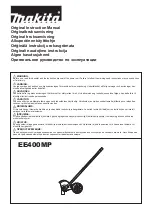
14DBP-001
22
ADJUSTING BRAKES (WITH FIXED LEVERS)
Every 3 Months
Take up the slack when the actuator stroke reaches about two thirds of the
maximum travel.
To adjust, turn the lever by one or more splines, ensuring that the brakes are not
touching when released
(to prevent overheating the brakes).
Never change the linkage position for the actuator on the lever. Always use the original hole
For braking systems which use a yoke, the yoke must remain parallel with the
axle especially when the brakes are fully applied
This means that the stroke of the levers on the brakes at each side must be
identical. Otherwise, the brake slack must be adjusted.
ADJUSTING BRAKES (WITH ADJUSTABLE LEVERS)
Every 3 Months
Take up the slack when the actuator stroke reaches about two thirds of the
maximum stroke
Never change the linkage position for the actuator on the lever. Always use the original hole
To take up the slack, turn the adjustment screw on the lever to adjust the relative
position of the cam and the lever
NB. The actuator brakes by pushing the
lever to turn it in a particular direction. The screw must be adjusted so that
the cam moves in this direction to take up the slack.
The direction in which the screw must be
turned depends on the configuration of the axle.
Ensure that the brakes are not touching when
released (to prevent overheating the brakes).
For braking systems which use a yoke, the yoke must remain parallel with the
axle especially when the brakes are fully applied
This means that the stroke of the levers on the brakes at each side must be
identical. Otherwise, the brake slack must be adjusted.
Checking Clearance and wear
Check and test the brakes before intensive use and every 3 months:
Check the brake wear and the clearance between the brake linings and the drum visually.
It is probable that the linings are worn when the actuator travel has increased significantly.
Check the thickness of the brake linings
The brake shoes should be replaced as soon as the minimum lining thickness is reached.
Check that the brakes are clean and clean them if necessary
Suspensions & Brakes
Summary of Contents for DB30
Page 1: ...14DBP 001 DB30 DB40 DB50 DB70 OWNERS MANUAL ...
Page 5: ...14DBP 001 5 TECHNICAL DATA DB30 ...
Page 6: ...14DBP 001 6 TECHNICAL DATA TECHNICAL DATA DB40 ...
Page 7: ...14DBP 001 7 TECHNICAL DATA TECHNICAL DATA DB50 ...
Page 8: ...14DBP 001 8 TECHNICAL DATA TECHNICAL DATA DB70 ...
Page 25: ...14DBP 001 25 Diagram Mechanical Breakdowns ...
Page 26: ...14DBP 001 26 ...
Page 27: ...14DBP 001 27 ...
Page 28: ...14DBP 001 28 ...
Page 29: ...14DBP 001 29 ...
Page 30: ...14DBP 001 30 ...
Page 31: ...14DBP 001 31 ...
Page 32: ...14DBP 001 32 ...
Page 33: ...14DBP 001 33 ...
Page 34: ...14DBP 001 34 ...
Page 35: ...14DBP 001 35 ...
Page 36: ...14DBP 001 36 ...
Page 37: ...14DBP 001 37 ...
Page 38: ...14DBP 001 38 ...
Page 39: ...14DBP 001 39 ...
Page 40: ...14DBP 001 40 ...
Page 41: ...14DBP 001 41 ...
Page 42: ...14DBP 001 42 ...
Page 43: ...14DBP 001 43 ...
Page 44: ...14DBP 001 44 ...
Page 45: ...14DBP 001 45 ...
Page 46: ...14DBP 001 46 ...
Page 47: ...14DBP 001 47 ...
Page 48: ...14DBP 001 48 ...
Page 49: ...14DBP 001 49 ...
Page 50: ...14DBP 001 50 ...
Page 51: ...14DBP 001 51 ...
Page 52: ...14DBP 001 52 ...
Page 53: ...14DBP 001 53 ...
Page 54: ...14DBP 001 54 ...
Page 55: ...14DBP 001 55 ...
Page 56: ...14DBP 001 56 ...
Page 57: ...14DBP 001 57 ...
Page 58: ...14DBP 001 58 ...
Page 59: ...14DBP 001 59 ...
Page 60: ...14DBP 001 60 ...
















































